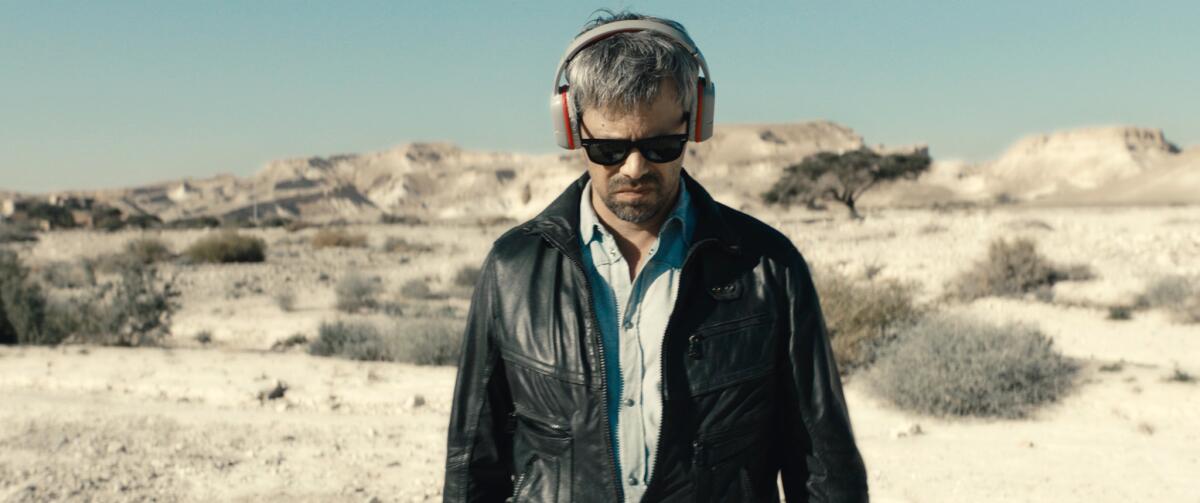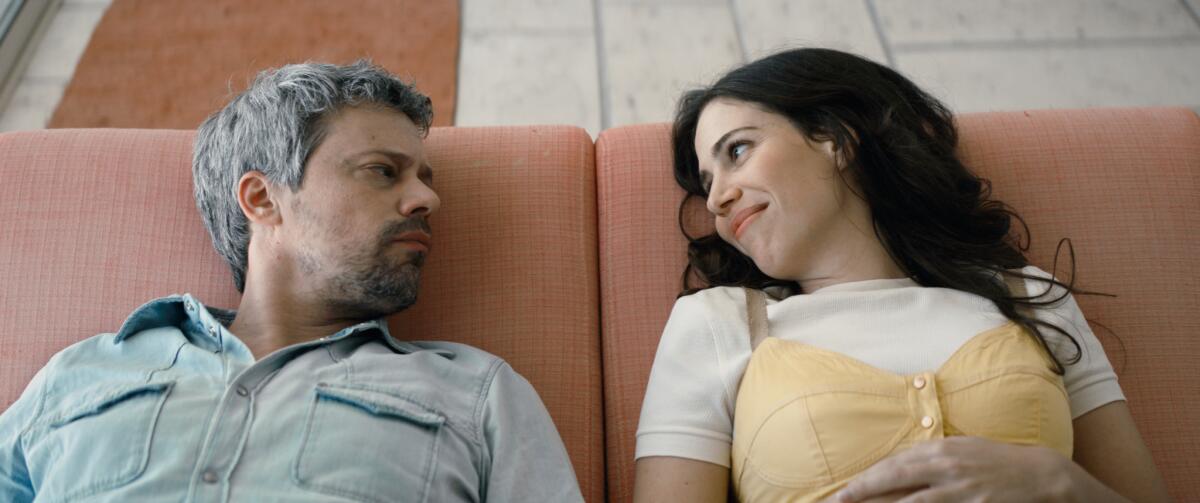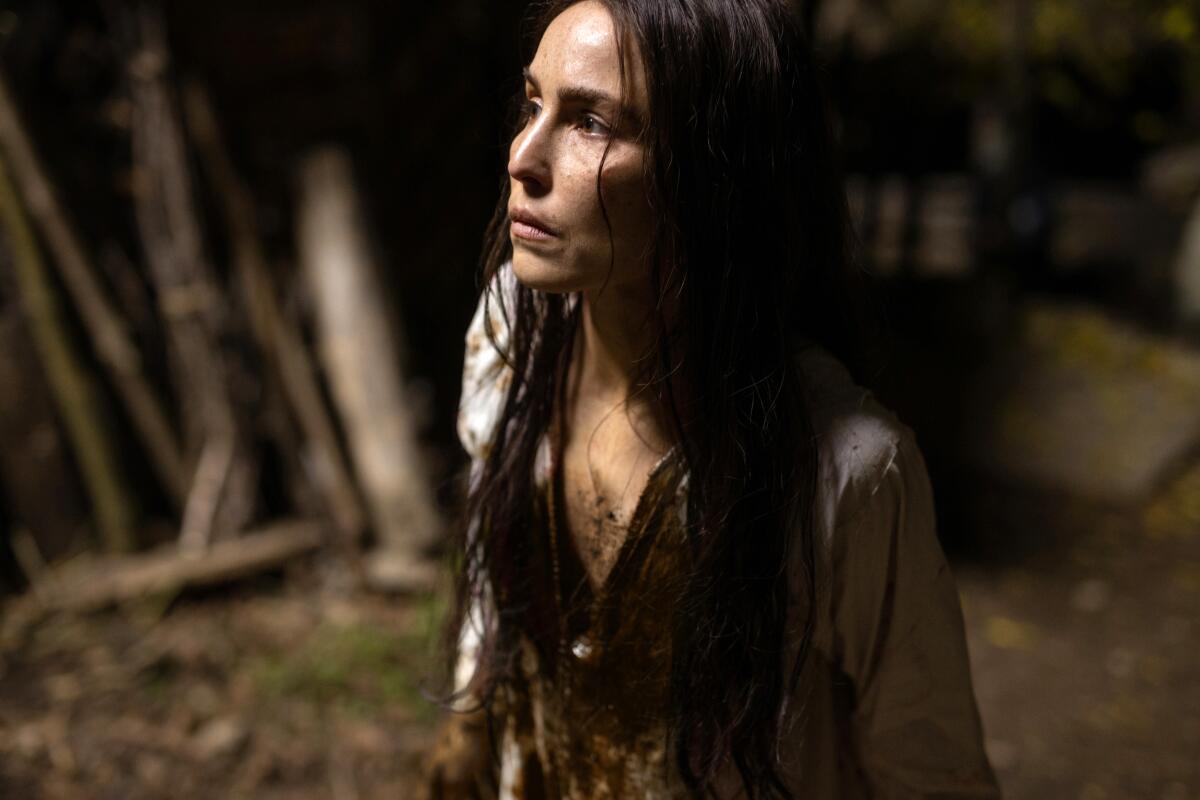A filmmaker rages in ‘Ahed’s Knee’

- Share via
Hello! I’m Mark Olsen. Welcome to another edition of your regular field guide to a world of Only Good Movies.
Only good movies
Get the Indie Focus newsletter, Mark Olsen's weekly guide to the world of cinema.
You may occasionally receive promotional content from the Los Angeles Times.
The Oscars, The Slap and moving forward. If you are a reader of this newsletter, you are also presumably more than aware of all that happened at least weekend’s Academy Awards. Aside from the continuing fallout over what is now known simply as The Slap, my colleagues Glenn Whipp and Josh Rottenberg took a look at everything else that was wrong with the ceremony and what it means for the academy moving forward, including how to deal with those awards presented before the live broadcast and a general sense of awkward reticence around the very films being celebrated.
Darian Symoné Harvin wrote about the specifics of hair and its relationship to the events of the evening, noting, “Hair was at the center of the moments that left viewers’ jaws dropped — in joy and disbelief. We watched, desperately and frantically, trying to process what we just witnessed. Hair carried the event and did exactly what hair does — elevate it to the level of art.”
For “The Times” podcast, Erin B. Logan spoke to Erika D. Smith about the politics of hair and Black women, not only regarding Jada Pinkett Smith and the Oscars but also prospective Supreme Court Justice Ketanji Brown Jackson and recent anti-discrimination bills.
Bruce Willis retires. In additional unexpected news this week, the family of Bruce Willis announced he was retiring from acting due to a diagnosis of aphasia. Amy Kaufman and Meg James published a story about how Willis’ condition had been affecting his ability to work and why he had shot roles in some 22 movies in the past four years, typically working for only a few days on each.
As Terri Martin, production supervisor on one of Willis’ recent productions, put it, “He just looked so lost, and he would say, ‘I’ll do my best.’ He always tried his best. … He is one of the all-time greats, and I have the utmost admiration and respect for his body of work, but it was time for him to retire.”
Anita Loos’ films at UCLA. The UCLA Film & Television Archive is launching an exciting new ongoing series titled “This Woman’s Work: How Gender Shaped Cinema From Behind the Scenes,” which moves away from a director-centric view of filmmaking to focus on other areas of production. The series begins with a spotlight on screenwriter Anita Loos throughout April, with a lineup including “The Women,” “Blondie of the Follies,” “San Francisco,” “When Ladies Meet” and “Gentlemen Prefer Blondes” and featuring such stars as Clark Gable, Jean Harlow, Spencer Tracy, Joan Crawford, Rosalind Russell, Jane Russell and Marilyn Monroe. The screenings are all free and are all being projected from film prints.
Enjoying this newsletter? Consider subscribing to the Los Angeles Times
Your support helps us deliver the news that matters most. Become a subscriber.
‘Ahed’s Knee’
Written and directed by Israeli filmmaker Nadav Lapid, “Ahed’s Knee” stars Avshalom Pollak as a character simply known as Y, a disaffected filmmaker who comes to a small town for a screening of his work. There he meets Yahalom (Nur Fibak), a Ministry of Culture functionary, and the two begin a back-and-forth on why they do what they do that becomes increasingly intense as they explore much larger issues of personal and political identity. The film is playing in limited release.
For The Times, Justin Chang wrote, “One thing nearly all Lapid’s movies share is an obsession with language, a concern for the precision of words but also an appreciation for their limitless possibilities. ‘Ahed’s Knee,’ perhaps even more so than its predecessors, tries to explode the conventions of traditional movie language, to find a formal syntax that will match the ferocity of its broadsides. … It’s not pretty, and it doesn’t care. ‘Ahed’s Knee’ means to shatter your complacency, and also the complacency of its chosen medium. You could see this as a childish act of revolt, or you could see it as Lapid, much like Y himself, refusing to submit to any agreed-upon parameters. He delights in coloring out of the lines, not least because he knows it will make all the right people mad.”
For the New York Times, A.O. Scott wrote, “The difference between the two directors might just be that Lapid gives vent to his despair by making a movie — with beautiful, hallucinatory shots of the Arava and splinters of comic absurdism — whereas Y throws a tantrum, alienating his audience and humiliating his biggest fan. Or: the real filmmaker retreats into his art, whereas his fictional counterpart is bold enough to make a scene, hurt some feelings and possibly risk his own comfort and career. Neither one asks to be taken as a hero. … The privileges granted to artists can always be held against their art, and so can their personalities. It’s possible to reach the end of ‘Ahed’s Knee’ with just one question in mind: What is this guy’s problem? The answer is complicated, because it isn’t only one guy’s problem.”
For Vulture, Bilge Ebiri wrote that Lapid is “interested in how the inescapable moral quagmire of society manifests itself in erratic behavior, and he makes erratic films to capture the psychology behind such behavior. Maybe that’s why his work regularly resonates beyond Israel. … So even as ‘Ahed’s Knee’ opens up to deliver a filmmaker’s cri de coeur about the state of his country, it also dares to ask where goodness lies, which is a far more universal and relatable question. At what point does constant aggrievement become its own toxic form of aggression? At what point does rage become cruelty? But also: At what point does merely going about one’s business perpetuate great evil? What is the threshold for quietly participating in an oppressive system? Humanity has never had easy answers to such questions, and neither does ‘Ahed’s Knee.’ And so, the movie itself shrieks, and flails, and breaks, and burns. It might be a masterpiece.”
For Variety, Jessica Kiang wrote, “‘Ahed’s Knee’ has the feeling of a film made quickly, rashly, before anyone could shut it down, but also one conceived in a state of grief and stuck, for the duration, in its furious second stage. If you didn’t know that it was written in the immediate aftermath of the death of Lapid’s mother (who was his editor on all his other features) you might guess as much from this undertow of intense loss, a bewildered, belligerent sorrow from which no words, not even such perfectly simple and lovely words as ‘You are good,’ can save you.”

‘Nitram’
Directed by Justin Kurzel from a screenplay by Shaun Grant, “Nitram” is based on the 1996 mass shooting in Port Arthur, Australia. Continuing Kurzel’s ongoing examinations of Australian violence, including “The Snowtown Murders” and “True History of the Kelly Gang,” the film won an acting prize for Caleb Landry Jones at last year’s Cannes Film Festival and also features Judy Davis, Essie Davis and Anthony LaPaglia. The film is playing in limited release and is available on VOD and AMC+.
For The Times, Robert Abele wrote, “This is no elegy for a misunderstood outcast. Nor is it a sensationalized portrait of a sicko. In its watchful patience, it’s a character study of unmanageability inside a small orbit of loneliness and despair, building its unease brick by brick until the inevitable reveals itself to be the thing that nobody could have foreseen, yet was unconscionably, harrowingly easy to facilitate. … ‘Nitram’ is social realism designed to scare you into clarity about what gets ignored when lives get smaller and vulnerability mutates. It’s with a gut-wrenching helplessness that we watch the ingredients assemble for what has become our seemingly most preventable modern scourge — someone far gone, armed with what’s all too available.”
For the New York Times, Jeannette Catsoulis wrote, “[Kurzel] has created a bleak and passionless tale wrapped in a caul of inevitability. Rather than analyze his subject, the director steers us to the external factors — an inattentive physician, a shocking lack of effective gun laws — that eased his path to destruction. The killings themselves may remain off-camera, but the movie is still an uncomfortable watch. In Jones’s smoldering performance, we see a man stretched beyond his limits, a rubber band just waiting to snap back.”
For IndieWire, David Ehrlich wrote, “Kurzel is well aware that such atrocities only create a short window of time to enact legislative change; he knows that ‘Nitram’ is several decades too late. So he and Grant have strived to make something that might inspire a change of culpability, instead — something that firmly places the guilt on the perpetrator (and on his parents, to a certain extent), while also making it clear that the onus for responding to it falls squarely on ‘us.’ That we’re no different than that little boy in the Tasmanian burn unit who, when asked if he’s learned his lesson about playing with firecrackers, bluntly responds ‘Yes, but I’m still playing with them.’ It’s a chuckle-worthy moment in a kids say the darndest things kind of way, but you won’t be laughing by the time ‘Nitram’ leaves us feeling like the butt of the joke.”

‘You Won’t Be Alone’
The feature debut of writer-director Goran Stolevski, “You Won’t Be Alone” is a folk-horror tale of a witch, known as the Wolf-Eateress among 19th century Macedonian villagers, and a shape-shifting young woman who takes on the form of others, learning what it means to go from isolation to living among a community. The international cast includes Noomi Rapace, Anamaria Marinca, Carloto Cotta and Alice Englert. The film is in theaters now.
For The Times, Katie Walsh wrote, “Filmed in a lyrical, intimate manner, utilizing a handheld camera to capture the beauty of nature and the expression of each actor, the story of ‘You Won’t Be Alone’ is told almost entirely visually. … There are moments when you want to look away from ‘You Won’t Be Alone,’ but it’s so wildly compelling, in performance, writing and score, that one cannot. It feels like something unearthed from another time, an ancient relic that is utterly modern in its craft and in the truths it tells about the world. It is startling, and sometimes disturbing, but hits a place that is intensely human — bittersweet and bloody and beautiful at once, and unlike anything you’ve ever seen. Is it horror? Well, life can be a horror. And yet …”
For Vanity Fair, Richard Lawson wrote, “While certainly a treatise on a long and horrible history of the mistreatment of women, ‘You Won’t Be Alone’ is also about a fundamental constant shared by all people. It’s not just gender, not just sex, not just spiritual hunger, but all that is contained and grasped within the gift (and curse) of bodily consciousness, our awareness of self and others that can be—and so often is—utilized for terrible harm. It can also be the engine of deepest empathy, of vital connection. Of feeling, prickling all around us, the peculiarly comforting sentiment of the film’s title. … Amidst all the woe both inevitable and avoidable, there is the pressing on, the want and wish for—held in the more to come, we have to believe—the potential for better.”

Only good movies
Get the Indie Focus newsletter, Mark Olsen's weekly guide to the world of cinema.
You may occasionally receive promotional content from the Los Angeles Times.




